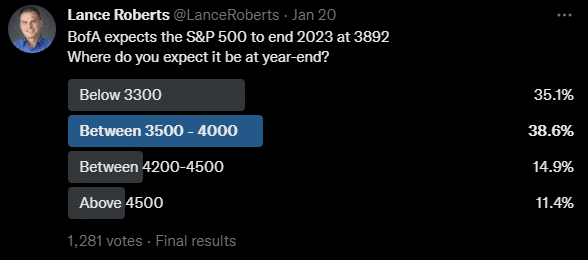The Art of Contrarian Investing
From a contrarian investing view, everyone remains bearish despite a market that corrected all of last year. I polled my Twitter followers recently to take their pulse on the market.
 Lance Roberts Tweet
Lance Roberts Tweet
Of the 1280 votes cast in the poll, roughly 73% of respondents anticipate the market to be lower throughout 2023. That view also corresponds with our sentiment gauge of professional and retail investor sentiment, which, while improved from the October lows, remains depressed.
 Net Bullish Sentiment vs S&P 500
Net Bullish Sentiment vs S&P 500
More importantly, investor allocations, particularly among professional investors, remain extremely light, suggesting a much higher level of caution. The following is the 4-week moving average of the National Association of Investment Managers bullish index. While the reading of 25.04 in October coincided with the market low, the current reading of 48.16 remains bearish.
 NAAIM 4-week Avg vs S&P 500 Index
NAAIM 4-week Avg vs S&P 500 Index
As Bob Farrell’s Rule Number 9 states:
As a contrarian investor, excesses are built by everyone betting on the same side of the trade. When the market peaked in January 2022, everyone was exceedingly bullish, and no one was looking for a 20% decline. Sam Stovall, the investment strategist for Standard & Poor’s, once stated:
Today, everyone remains bearish, suggesting the possibility of the market doing something no one expects.
The Art of Contrarianism
As we have often discussed, one of the investors’ most significant challenges is going the prevailing market However, historically speaking, contrarian investing often proves to provide an advantage. One of the most famous contrarian investors is Howard Marks, who once stated:
“
As noted, a majority of investors remain bearish. There are certainly ample reasons to BE bearish:
We certainly agree with the more dismal outlook and continue to suggest that investors should be more cautious in their portfolio allocations. However, this is also the point where investors make the most mistakes. Emotions make them want to avoid the risk of loss.
Given that many investors have never witnessed a the current bearing sentiment is unsurprising. The increased price volatility, and subsequent decline in prices, created a substantially higher level of instability. That instability creates “fear” and drives investors to the behavioral bias of
 Periods of Low and High Volatility
Periods of Low and High Volatility
That increased volatility weighs on investor sentiment leading to poor investment decision-making and, ultimately, poor outcomes.
However, if the most fundamental premise of investing is to investors may again be missing the contrarian opportunity.
With the market negatively positioned, the contrarian trade is an expectation of the unexpected.
The fundamentally bearish arguments of valuations, earnings, a Fed policy mistake, and a recession are certainly viable outcomes.
However, given that is already expecting those outcomes, what happens if something else occurs?
Navigating a Contrarian Trade
As Bob Farrell’s Rule Number-9 states:
As a contrarian investor, excesses get built when everyone is on the same side of the trade.
Everyone is so bearish the markets could respond in a manner no one expects.
There are plenty of reasons to be very concerned about the market over the next few months. Given the market leads the economy, we must respect the market’s action today for potentially what it is telling us about tomorrow. Therefore, there are some actions we can take to navigate for whatever path the market chooses.
Just remember:
an investor has to be a “
Follow your process.



